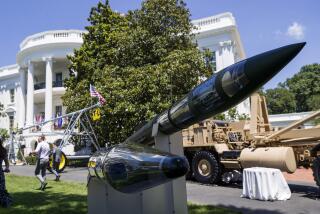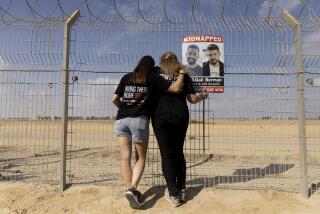Israelās āmiracleā anti-rocket defense plan raises anxieties
Reporting from Sderot, Israel ā The rockets may not strike as often these days, but residents of this working-class town say they canāt shake the anxiety that comes with living in Israelās most frequently bombed city.
Pedestrians strolling downtown keep an eye out for the nearest concrete-reinforced bus-stop shelter in case public loudspeakers crackle with a 15-second warning to dive for cover. Many motorists forgo seat belts so they can ditch vehicles quickly.
A playground is equipped with 5-foot-wide concrete pipes that are brightly painted to look like giant caterpillars but double as childrenās bomb shelters.
āThere is really no sense of security here at all,ā said Merilin Timsit, a 29-year-old mother of two.
Last month, the Israeli government said it was on the cusp of a technological breakthrough that would put such fears and precautions in the past. A new anti-rocket defense system, called Iron Dome, was presented as a high-tech umbrella that would allow Israelis to go about their lives while short-range rockets fired from Palestinian territories or Arab neighbors were blasted out of the sky.
But despite promising results in a much-touted test in January, Iron Dome so far has heightened as many tensions as it was supposed to relieve. Critics say the technology is not fast enough to work in cities such as Sderot, which is only a mile from militant strongholds in the Gaza Strip.
Some officials, including Israeli Prime Minister Benjamin Netanyahu, question the steep cost: as much as $1 billion for development and nationwide deployment.
Others warn against seeking technological solutions for threats better handled diplomatically.
āItās no silver bullet,ā said Yiftah Shapir, head of the military balance project at Israelās Institute for National Security Studies. āIn fact, itās not going to solve any of our problems.ā
Military officials this month began hinting that Iron Domeās initial deployment this summer would be smaller than expected and would focus on protecting military installations rather than Sderot, which many assumed would be the first town to benefit.
Sderot grocery store owner David Turjeman, 48, fumed at what many see as government backpedaling.
āIf itās not deployed, Iām going to sell my business and leave Sderot,ā said the father of three, whose house was damaged in 2008 by one of the 6,000 rockets and mortar shells fired at Sderot over the last four years. āIām not willing to go through that again. . . . I feel helpless.ā
Short-range rocket attacks have long been one of Israelās most-vexing military problems. The nation in the last decade has been targeted with more than 11,000 rockets and mortar shells by Hamas and other armed groups in Gaza. Israelās 22-day offensive against the coastal territory a year ago was largely an effort to halt the rocket barrage. The nationās northern towns have come under similar attack from Hezbollah fighters in Lebanon.
Many of these homemade projectiles land in open spaces without causing major damage. But about three dozen Israelis have been killed over the last decade in the south.
The rockets take a heavy toll on the publicās psyche and can wreak economic havoc because of business closures and lost productivity, experts say.
Since the Gaza cease-fire, rocket attacks have declined sharply, but Israelās military continues to search for a defensive system to neutralize the threat. Israeli military contractor Rafael Advanced Defense Systems announced in January that its mobile rocket-interceptor system, developed with the military, was nearly ready to deploy.
The system uses radar to detect a rocket launch, quickly computes whether the projectile is headed toward people or buildings, and then dispatches an interceptor missile to destroy it. Rockets headed toward open spaces are allowed through. Similar technologies have been designed by the U.S. and others to knock out mid- and long-range projectiles, such as the Patriot surface-to-air missile system.
Some critics say such technology will not work against short-range rockets, which can strike in 15 seconds or less and at distances of less than two miles.
Based on the preliminary details released by Rafael, outside experts have concluded that Iron Dome requires at least 30 seconds to respond.
āA Kassam rocket can hit Sderot in about 14 seconds, so thereās no way Iron Dome can defend it,ā said Reuven Pedatzur, a Tel Aviv University lecturer and defense analyst.
Pedatzur, a former air force fighter pilot, said defensive systems like Iron Dome arenāt the right approach for dealing with short-range rockets.
āIf you want a military solution, you should attack the area,ā he said. āOr you could reach a [political] agreement with the other side.ā
Pedatzur said reliance on Iron Dome could hinder peace talks if Israelis become overconfident.
āEverybody will say, āWhy do we need a [political] solution? We have the perfect defense.ā ā
The system is expensive. Each mobile battery costs about $25 million, according to Rafael. Interceptor missiles reportedly cost up to $50,000 apiece.
That compares with as little as $50 needed to construct each of the Kassam rockets favored by Palestinian militants, which are usually produced in low-tech factories using old pipes, fertilizer and scrap metal.
Netanyahu has praised Iron Dome as a technological āmiracle,ā but he also referred to the system as āprohibitively expensive.ā
Yossi Drucker, project director at Rafael, said critics are wrong in their estimates about Iron Domeās response time, though he said such details are being kept secret for security reasons.
āIron Dome can protect Sderot against all the threats it faces,ā he said.
Drucker added that Iron Domeās costs should be considered in relation to the economic effect of rocket barrages or the cost of another war. During Israelās 2006 war with Hezbollah, the estimated cost from rocket attacks on cities in the north -- both damage and lost productivity -- was nearly $1 billion, he said.
Defense Ministry spokesman Shlomo Dror said no final decisions had been made about where Iron Dome would be deployed, but he said the initial rollout would include two self-contained systems, each capable of covering about a 45-mile area. Previously, Rafael and military officials had spoken about deploying seven systems.
Dror emphasized that each system can be moved around the country in response to threats. Rafael and the military are also hoping to sell the technology to the United States and other countries to help defray costs.
Some observers see the development of Iron Dome as a political strategy rather than a military one, aimed at intimidating enemies and bolstering confidence among the Israeli public.
āItās no accident that thereās been so much press attention to this on the home front,ā said security analyst Meir Elran, former deputy head of military intelligence for the Israel Defense Forces.
āItās part of a campaign by the government and Defense Ministry to show that they are active and responsive.ā
edmund.sanders @latimes.com
More to Read
Sign up for Essential California
The most important California stories and recommendations in your inbox every morning.
You may occasionally receive promotional content from the Los Angeles Times.










